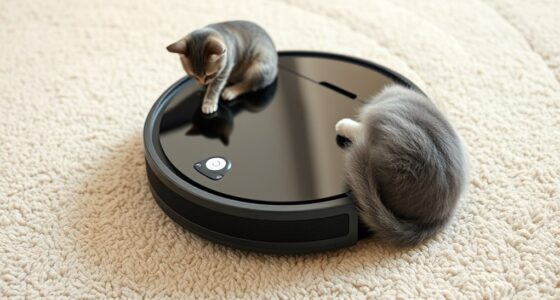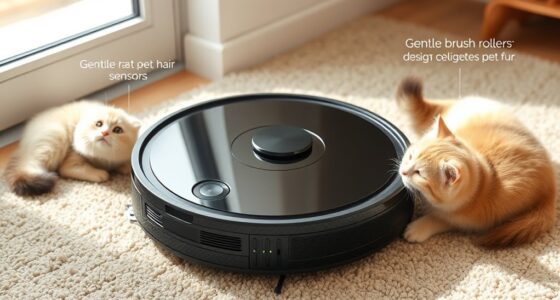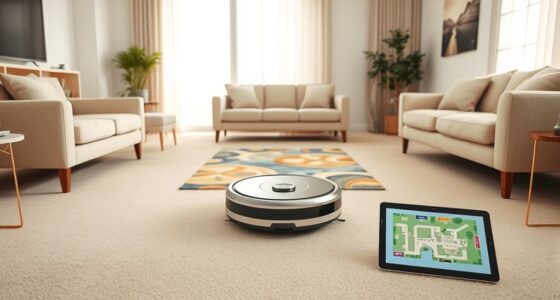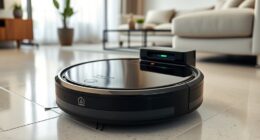Robot vacuums can be quite eco-friendly if you choose models designed with energy efficiency in mind. They use less power by incorporating smart sensors, adjustable modes, and efficient motors, which helps reduce your carbon footprint. Premium options often offer longer battery life and quicker recharging to save energy overall. By selecting a more efficient model and understanding how they operate, you can enjoy clean floors while supporting sustainability efforts. Discover more ways to maximize their eco benefits.
Key Takeaways
- Modern robot vacuums are designed to use less energy through advanced sensors and adaptive cleaning modes.
- Energy-efficient models feature smart power management, reducing electricity consumption during idle or low-dirt conditions.
- Rechargeable lithium-ion batteries and optimized motors help extend operation time while minimizing energy use.
- Features like automatic return-to-dock and dirt detection prevent unnecessary cleaning cycles, conserving power.
- Choosing eco-friendly, energy-efficient robot vacuums supports household sustainability and reduces your carbon footprint.

Ever wonder how much energy your robot vacuum consumes during cleaning? It’s a common question for anyone trying to reduce their carbon footprint while keeping their home tidy. The answer depends heavily on the robot’s efficiency and its power consumption. When you run your robot vacuum, it’s not just about the cleaning performance but also about how much energy it uses to get the job done. Modern robot vacuums are designed with energy efficiency in mind, but their power consumption can vary based on several factors. Cheaper models might use more energy because they lack optimized motors or smart power management features, while premium models often incorporate advanced technology to minimize energy use without sacrificing cleaning quality.
Understanding your robot vacuum’s energy use helps reduce your carbon footprint effectively.
The key to understanding how eco-friendly your robot vacuum is begins with analyzing its robot efficiency. A highly efficient robot uses less power to clean just as thoroughly as a less efficient one. Manufacturers often highlight features like smart sensors and adaptive cleaning modes that help the vacuum target dirt more precisely, reducing unnecessary operation and conserving energy. For instance, some models can detect when a room has already been cleaned or when it’s time to return to their charging dock, automatically shutting down or entering low-power standby mode. These intelligent functions directly influence the overall power consumption, making your robot vacuum more eco-friendly. Additionally, battery technology improvements contribute to longer-lasting power and more energy-efficient operation.
Power consumption is another critical element. Most robot vacuums operate on rechargeable batteries, typically lithium-ion, and their energy draw can vary depending on factors like motor size, suction power, and brush design. Higher suction settings tend to consume more energy, which can increase your overall electricity usage. However, many newer models allow you to customize cleaning modes, so you can choose a lower power setting for light cleaning sessions, saving energy over time. Additionally, the efficiency of the charging process and how quickly your robot recharges also play a role in its overall energy footprint. A robot that charges quickly and uses minimal power during operation reduces your environmental impact.
In essence, the eco-friendliness of your robot vacuum hinges on how well it balances cleaning power and energy consumption. Look for models that emphasize efficiency, have smart sensors, and offer adjustable settings. These features help ensure you’re not wasting electricity on unnecessary extra cleaning cycles. When you select a robot vacuum with high robot efficiency and low power consumption, you’re making a more sustainable choice. Not only will it keep your floors spotless, but it’ll also minimize the energy drain, making your cleaning routine more environmentally responsible.
Frequently Asked Questions
Do Robot Vacuums Consume More Energy Than Traditional Vacuum Cleaners?
You might wonder if robot vacuums use more energy than traditional ones. Generally, robot vacuums have lower power consumption compared to full-sized models, thanks to their smaller size and efficient motors. When looking at power consumption comparison and energy efficiency metrics, robot vacuums tend to be more eco-friendly because they use less energy for regular cleaning. So, they’re often a greener choice, especially if you compare their overall energy use.
Can Robot Vacuums Operate Efficiently on Energy-Saving Settings?
You can operate your robot vacuum efficiently on energy-saving settings by utilizing smart scheduling and power optimization features. These settings help reduce energy consumption while maintaining cleaning performance. When you choose eco-friendly modes, your device conserves power, making it more environmentally friendly. By setting schedules during off-peak hours and enabling power-saving options, you maximize efficiency and minimize energy use, helping you create a greener, more sustainable cleaning routine.
How Does Battery Lifespan Affect Overall Energy Consumption?
Battery lifespan directly impacts your robot vacuum’s energy efficiency. As battery degradation occurs over time, the vacuum may need to work harder or recharge more often, increasing overall energy consumption. When your battery starts to lose capacity, it consumes more power, reducing eco-friendliness. To maintain peak energy use, keep an eye on battery health, and consider replacing it when degradation affects performance.
Are There Eco-Friendly Robot Vacuum Models Available?
You’ll find eco-friendly robot vacuum models that use sustainable materials and are designed to minimize energy use. These models often operate on batteries charged with renewable energy, reducing their carbon footprint. By choosing such vacuums, you support sustainability and lower environmental impact. Look for brands prioritizing eco-conscious features, ensuring your cleaning habits align with your green values while maintaining efficiency.
What Is the Environmental Impact of Manufacturing Robot Vacuum Batteries?
The environmental impact of manufacturing robot vacuum batteries mainly involves sourcing materials sustainably and promoting battery recycling. You can help reduce this impact by choosing models that prioritize material sustainability and support battery recycling programs. Responsible manufacturing minimizes resource extraction and waste. By making eco-conscious choices, you contribute to lowering the overall environmental footprint of robot vacuum batteries, encouraging more sustainable practices in the industry.
Conclusion
So, next time your robot vacuum whirs to life, remember you’re not just saving time—you’re pretending to save the planet too. Sure, they sip power like a fancy espresso, but hey, at least they do it quietly while you binge-watch your favorite show. Who knew that tiny machine zipping around could be the hero we never asked for in the fight against eco-unfriendliness? Just don’t forget to plug it in—saving the world starts with a full battery.








